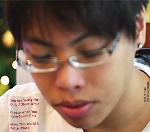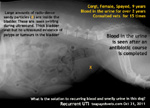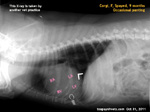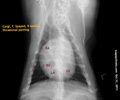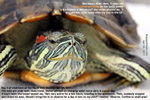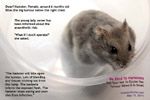Every dog owner and probably person will be warned about anaesthetic risks. For owners who don't want the risk, there are groomers in Singapore who find this opportunity to provide a service involving dental scaling of dogs without any anaesthesia.
Vets do not use anaesthetic on dogs unnecessary to avoid any anaesthetic risks as the high emotions of grieving of dogs dead during anaesthesia are terrible for the vet and the staff.
Since most dogs will not tolerate manual dental scaling, the groomer's assistant must grip the dog's legs tight to enforce cooperation. It is like the old days when people are held tightly by men during surgeries or given a dose of whisky. In dogs, the groomer can't sedate as the service is supposed to be no anaesthetic or sedation.
Recently I had a case of a poodle that had stopped eating for over 3 days and could not stand up. The two teenaged daughters were worried that their dog may die. The mother had taken the dog to a groomer in Sembawang pet shop to get dental scaling done. I remembered this case as the mother was running a mini-mart and I had vaccinated her dog some 3 years ago. It was a puppy then. I had the dog's blood checked, gave the IV drip and antibiotics. There was hypoglycaemia. The dog's mouth probably was very painful after enforced dental scaling by the groomer and so he would not eat. He recovered within 2 days of treatment and went home to two happy teenaged daughters and a relieved mother.
Yesterday, Oct 31, 2011, I had this 9-year-old Corgi whose lady owner was vacillating as to whether to get her dental scaling done or not. Her dog would lick at the vagina after the course of antibiotics lasting as long as one month and the urine would have blood clots or blood when all the antibiotics have been taken.
She had consulted several vets in one brand name practice for more than 10 times over the last two years after being referred to this practice by another vet who could not cure her dog's blood in the urine problem. This was because the brand name practice has all the facilities, according to the vet referring her to this practice. Ultrasound of the kidney and bladders, urine tests, urine culture and sensitivity and blood tests were done at various times over the two years. There was said to be an X-ray done but the practice said there was no record available.
|
Corgi, Female, Spayed, 9 years -
Recurrent UTI. No blood in urine when given
antibiotics Some lab results from Vet 2 Blood in urine on 29-10-11 again. Phoned Dr Sing. Very smelly urine when examined. |
|||||||||
| Date | 3-9-11 | 4-4-11 | 20-3-11 | 27-2-11 | 19-9-11 | 3-7-10 | 27-5-10 | 9-1-10 | 20-4-10 |
| SG | 1.034 | 1.036 | 1.048 | 1.024 | 1.042 | 1.037 | |||
| pH | 7.4 | 6.5 | 7.7 | 7.2 | 7.7 | 7.1 | |||
| Pn | + | 2+ | 2+ | 2+ | |||||
| RBC | >1000 | 2-4 | 20-30 | 2-4 | >500 | 200-300 | |||
| Bacteria | 2+ | + | 3+ | 2+ | + | 3+ | |||
| Struvites | 2+ | 3+ | 1+ | 3+ | |||||
| Polyps | present | No significant growth | |||||||
| Urine Culture | Proteus mirabilis |
||||||||
| Ultrasound | Polypoid cystitis | Chronic cystitis | Bladder wall thickened. floating echogenic | ||||||
| WBC | 6-8 | 2-4 | 4-8 | 4-6 | 0-2 | 40-50 | |||
| Others | Blood test normal | Bladder not palpable, fat, pollakiuria, stranguria | Obese, vulval fold and muzzle eczema | ||||||
|
Vet 2's lab reports give some
clues to the recurrent UTI. It is always easier
to diagnose with lab reports done. The case is
being followed up by me. Ultrasound on Oct 29,
2011 revealed no stones, polyps or transitional
cell carcinoma inside the bladder but lots of
floating cellular masses. Struvites stones
not seen in 2 X-rays but there were radio-dense
urine, On the first day, no urine was available from this female dog for test. Catherisation would need anaesthesia and I did not do it since lab results from Vet 2 showed a pattern of struvite formation. It was not possible to wait for the urine as the dog had to go home. No urinary crystals on urine test, pH=7.0 from urine test taken by the owner 2 days after Dr Sing's antibiotic treatment. My present treatment aims at dissolving the struvite and preventing its formation inside the bladder. Antibiotics. Urine acidified. SD diet to dissolve struvites advised for 3 months. Owner took 1 month's supply of SD diet first. Needs monthly follow-up but most owners don't contact the vet till blood appears in the urine. Recurrent UTI is a difficult problem to resolve and the blood in the urine is very worrying to the owner. Will there be a solution? It is hard to say now. |
|||||||||
But her dog would pass smelly urine with blood after a
course of antibiotics prescribed by these vets. She
was not happy with this situation. One vet had advised
surgery of the bladder to remove "polyps" but had told
her about anaesthetic risk and that the surgery was
not meant to be a cure for the recurring problem of
passing blood in the urine.
She phoned me to seek another opinion recently. I have
the benefit of these tests. Three urine tests at
different times showed struvites in the urine. The
facilities or tools of the trade were used by the vets
but the owner's problems were not resolved.
It was like my car's problem. My car would display
"Check coolant level" and I would send the car to my
usual mechanic for 4 times. The mechanics were two
older men in their late 60s distinguished with
snow-white hairs and specialising in the brand of car
I drove. I presumed they must have the experience as
their hairs were all white. I never bargained or
squeezed them for discount after they service my car,
as is the case with many pet owners at Toa Payoh Vets.
At the 4th time "Check coolant level," message
flashed, I asked the mechanic whether he could do the
job. I had to replace 2000 ml of water in 5 days after
he had assured me that he had resolved my problem.
I cannot afford putting my car overnight and then
encounter the same problem again. The old man pointed
to some water spots on the radiator and said he knew
what to do. He diagnosed the radiator cap as being
damaged and therefore leaked the coolant. He said he
had used pressure tests and there was no other
leakage. Earlier he had put some liquid which could
seal any cracks but they did not work.
Yet, I got the same problem. On the 5th time, he said
he would check again. He said the 5-month-old
German-made radiator was faulty and had replaced with
a French-made radiator. The supplier of the
German-made radiator would not provide a replacement
and therefore I had to pay him $500. "The 'check
coolant level' was reported within 2 months of getting
the German-made radiator," I said. "I wish to speak to
the distributor as he is selling faulty goods and
cheating people." The old man said it was of no use.
"I was referred to another mechanic down the road," I
said to the old man. "You could not resolve my problem
for so many times."
With the new radiator replaced, I checked the water
level 5 days later. There was a need to top up 200 ml
of water. So, was there a leakage or not? I have to
wait and see.
My situation is similar with that of the Corgi owner
as I entrusted my mechanic to resolve my problem. He
recommended replacement of the radiator and some pumps
and the bill came up to $7,000!
Only that she had consulted the same practice for over
10 times without resolution of her problems and I
would not be surprised if she had spent $7,000 too. I
did not ask her. But I could empathise with her.
DENTAL SCALING DONE TODAY
I use the same guideline for sedation
A 10-kg healthy young dog - 0.4 ml domitor + 0.5 ml
ketamine IV
The Corgi weighed around 14 kg but she was old. Blood
tests were normal but no chest x-ray of the heart was
done today as this is the usual practice. In human
anaesthesia, a chest x-ray at Singapore General
Hospital where I went for surgery, was mandatory.
In this Corgi, I gave 0.1 ml domitor + 0.1 ml ketamine
mixed with 0. 3 ml normal saline and gave IV. This was
less than 20% of the formula but the dog was sedated
80%. I used isoflurane gas to top up.
"No need," my assistant Min said when I told him to
apply a tourniquet.
"Sometimes it is not needed," I said. "But I see that
you have wasted a lot of time in some cases where no
tourniquet was used as the blood collection or
injection was not possible at the first attempt."
The dog had a tourniquet and the cephalic vein was
distended. The sedatives were given.
I monitored the isoflurane gas + oxygen very carefully
as the lady owner entrusted me and expected the dog to
be OK. Eyelid blinking to be zero and maintenance of
isoflurane was 0.5 - 1%. The dog had bilateral
cataracts but I could monitor the closing of the
pupil. It still took 45 minutes to complete the whole
dental scaling. Solid teeth. Tartar only esp. on PM4
upper, both sides.
The owner had said, "My dog had only one anaesthesia
and that was when she was spayed." I said: "That was
some 6 years ago and she was healthy then. I advise an
X-ray of the chest."
ULTRASOUND OF THE BLADDER AND X-RAY OF THE CHEST AND
ABDOMEN AT 11.30 AM
I collaborate with an experienced vet who did the
ultrasound and X-rays. I brought the Corgi personally
to discuss with him the use of the tools of the trade
- the ultrasound and the X-rays and how he would
interpret the results. I had wanted a contrast
cystography involving injecting dyes into the dog and
X-raying the kidneys and bladder to check for tumours
and stones. However the cost of $500 inclusive of
anaesthesia was above budget. I had to find other
lower cost alternatives and in any case, there was
anaesthesia which I had just performed during dental
scaling in the morning.
To cut a long story short, the ultrasound showed lots
of floating sandy particles inside the bladder as
reported by previous vets doing the ultrasound. There
was thickened bladder wall but no polyps or
transitional cell carcinoma inside the bladder.
"Otherwise the Doppler would show blood flowing into
the mass on the inside of the bladder," the vet I
collaborated with said to me. "There was zero blood
flow and therefore the sandy particles were separate
from any mucosa." Excellent use of the tools of the
trade, I must commend him.
On X-rays, I could see radio-dense bladder indicative
of struvites (as reported by urine tests by the
previous vets). The owner collected urine in the
morning but I had treated the dog with antibiotics 2
days ago. I wanted the X-ray to see if there were
large struvite stones. There were none.
The urine test I
sent to the lab today show normal urine. Amber, clear,
no nitrite, protein, glucose, ketones, urobilinogen
(normal), bilirubin, blood. Urine microscopy - no
white or ed blood cells, no epithelial cells, casts,
crystals, bacteria, mucus threads. yeast or others.
The pH was 7.0 (5-8) and SG was 1.018 (1.0905-1.030).
Based on history, the sandy particles would be
struvites or inflammatory cells.
I had to treat the dog 2 days ago as it was quite
distressing for the owner. In any case, urine
bacterial culture and sensitivity tests had been done
by the other vets and Proteus mirabilis was found in
one time. So, I did not repeat again to save the owner
some money. Baytril had worked and the dog was no more
passing blood in the urine while on antibiotics.
What is the next step now that the bladder is shown to
be free from tumours and polyps which would cause
recurrent UTI? I recommend dental scaling which was
done. The next step would be SD diet for 3-4 months to
acidify the urine. If this works, it will be happy
days for the owner. I will use urine acidifiers and
review the case in 4 weeks. Will I succeed where
others fail? Only time will tell whether I can resolve
the lady's pet problem of recurring UTI. This dog was
well beloved as not many Singapore owners would bother
to take the dog for over 10 times to treat for blood
in the urine. One or two times and that's it for the
old girl!
CONCLUSION
The history of the case reports from the other vets is
much more important than one urine test. At urine pH
of 7.0, it may be considered that the urine tends
towards alkaline.
I would say
that struvite sand and inflammatory cells are still present.
This is evident from the ultrasound where there is
"swirling" masses seen inside the bladder, as if it is
full of sand and debris. However, no blood supply
pulsates to any "polyps" nor are "polyps" seen in the
ultrasound. This indicates that the dog has no bladder
tumour.
The dog has chronic cystitis and recurrent UTI.
Tumours have been ruled out as a cause. Blood test
before antibiotic treatment was normal and so a
other-source of infection via the blood is ruled
out. This leaves struvites are a cause. The pH
7.0 is not acidic. Nor alkaline but this should be
reduced to produce acidic urine to stop bacterial
growth.
P.S. The dog's heart was enlarged but when I
auscultated the heart, the heart sounds were normal.
"Why is the heart enlarged?" the owner asked. "It may
be due to old age or congenital or other reasons," I
said. The dog did feel short of breath at certain
times. Will update this webpage as regards the
resolution of the dog's recurrent blood in the urine
problem.
 TOA
PAYOH VETS
TOA
PAYOH VETS